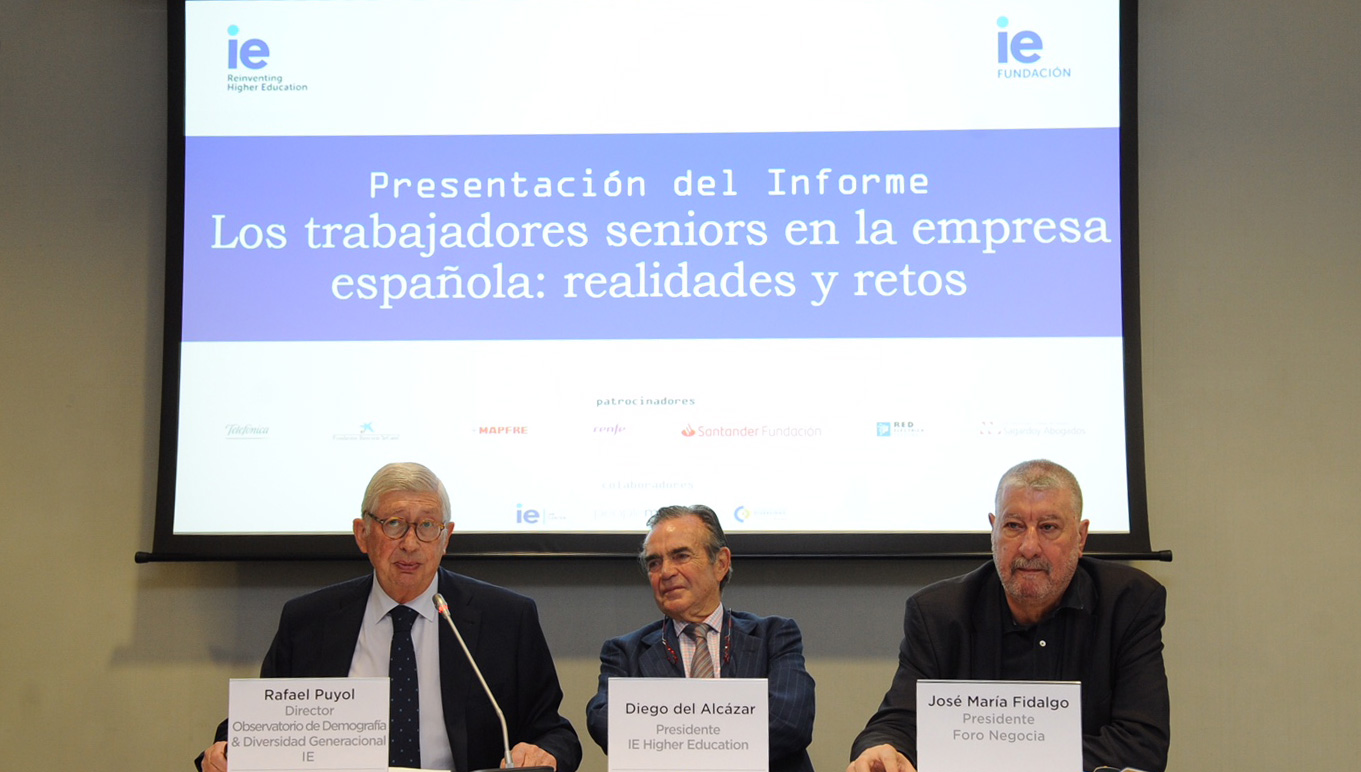
12 Jun Presentation of the report on Senior Employees in Spanish Business Organizations
(Versión en español más abajo)
IE Foundation Observatory on Demography and Generational Diversity reveals management of senior employees and the design of specific policies are key for the future of the labor market
- One in four inhabitants of Spain will be aged over sixty five by 2031.
- The findings of the study point to senior employees playing an increasingly important role in the Spanish economy over the next 10 years.
- Ninety per cent of companies do not have a plan of action for an ageing workforce. Only 15%, those with the highest turnovers and largest workforces, have early retirement schemes in place for senior employees.
Madrid, June 12, 2018. The management of senior employees and the design of specific policies for this particular segment of the active population will play a pivotal role in growing the labor market according to the findings of a report on Senior Employees in Spanish Business Organizations: Realities and Challenges. The report was presented today by Rafael Puyol, Director of the IE Foundation Observatory of Demography and Generational Diversity, who headed the study. The report underscores the fact that one in four inhabitants of Spain will be over 65 years old by 2031 due to the inexorable ageing process taking place in the labor market, the evolution of which will result in a new labor market with a very different structure. The study cross referenced its findings with the forecasts for demographic change and evaluated the experiences and best practices of 16 European companies with regard to managing employees aged over 55.
The study also found that there are several reasons workers over 55 years of age are in a good position to extend their working lives, such as the fact they are doing work which does not take such a toll on their physical health, they enjoy good health in general, and government policies now defend their right to work beyond the age of retirement and limit early retirement schemes. The report also found senior employees will play an increasingly important role in the economy over the next 10 years, which means it is essential to examine the impact of people working beyond retirement age and how it will affect productivity levels on a global level.
Profile of a senior employee
The study found that only 17.39% of the total number of employees in the companies that took part in the study were aged 55 or older, and only 0.52% were older than 65. Of these, 42.3% had a university degree and 11% had a postgraduate qualification. Eight per cent held senior management positions and they comprised 62.17% men and 37.83% women. The vast majority (77.6%) had been doing the same type of work since before the age of fifty five and almost 86% worked full time.
The study revealed that 90% of the participating firms had no plan of action in place for managing senior employees. Only 15% have early retirement schemes for senior workers, and these firms were those with the highest revenues and largest workforces. Sixty per cent offered partial retirement plans aimed mainly at workers aged from sixty to sixty four.
“An increasing number of companies are interested in a special focus on the management of senior employees coupled with the design of specific policies. We are, however, still in the very early stages of this process,” says Rafael Puyol. “Most companies are only implementing very specific initiatives, which are often isolated examples. Few firms are taking a holistic approach, which includes gauging the impact of measures taken and planning the structure of workforces on a medium-term basis using a road map with objectives and concrete projects.”
PeopleMatters is collaborating with the IE Foundation Observatory of Demography and Generational Diversity by examining best practices in senior employee management in European firms like Altadis, Correos, DKV, Gas Natural Fenosa, ISS Facility Services, Reale Seguros, Banco Sabadell, Zurich, ABB (Sweden), Axpo (Switzerland), Berner (Finland), BMW (Germany), Centrica (UK), Citibank (Greece), Loewe (Spain) and PSA Peugeot Citroën (France).
The key findings regarding best practices in the design of management plans for senior employees are as follows:
- Health and safety in the workplace. It is essential to design a plan of action with regard to healthcare and preventative measures in order to guarantee the physical and mental well-being and of senior employees to ensure optimum performance levels and less absenteeism.
- Organization and work environment. There is a need to design and implement initiatives in order to adapt positions to the profile of senior employees.
- Professional development. Firms have to foster the professional development of older employees and avoid knowledge obsolescence.
- Flexible retirement models. New, flexible work models that are compatible with retirement are key. These must be accompanied by lines of action aimed at easing the transition to this new phase in people’s lives.
- Preparation for retirement. Employees need to be made aware of key aspects of their post-retirement lives – financial planning, healthcare, leisure activities, hobbies, social relations, technology, etc.
- Age-based benefits. Recognition of the advantages enjoyed by the senior age group, both during their working lives and their subsequent retirement.
- Raised awareness and recognition of the value contributed by senior employees. Measures are required to foster an inclusive attitude toward senior employees and an appreciation of their contribution.
- Generational replacement and succession management. There must be actions aimed at streamlining the replacement of one generation by the next within business organizations in order to ensure a seamless transition.
The IE Foundation Observatory of Demography and Generational Diversity, headed by Rafael Puyol, was created in 2017 with the aim of carrying out research and activities in fields related to the effect of demographic variables on business. It has 7 key sponsors – Fundación Santander, Fundación Bancaria La Caixa, Mapfre, Red Eléctrica Española, Renfe, Telefónica, and Sagardoy Abogados – and enjoys the support of collaborating firms like PeopleMatters and a team of experts with extensive experience in the field.
– – – –
Presentación del informe sobre ‘Los trabajadores séniors en la empresa española: realidades y retos’
La gestión de los profesionales séniors y el diseño de políticas específicas, claves para el futuro del mercado laboral, según el Observatorio de Demografía de la Fundación IE
- Uno de cada cuatro habitantes en España tendrá más de 65 años en 2031.
- Los responsables del estudio señalan que elpeso de los trabajadores séniors va a aumentar en nuestra economía en los próximos 10 años.
- El 90% de las empresas no tiene un plan de actuación para sus trabajadores séniors. Sólo un 15% manifiesta tener planes de prejubilación para los empleadosséniors. Son las empresas de mayores ingresos y grandes plantillas.
La gestión de los profesionales séniors y el diseño de políticas específicas para este colectivo serán claves del crecimiento del mercado laboral, según refleja el informe sobre ‘Los trabajadores séniors en la empresa española: realidades y retos’ que ha presentado hoy Rafael Puyol, Director del Observatorio de Demografía y Diversidad Generacional de la Fundación IE y coordinador del trabajo. El informe destaca que 1 de cada 4 habitantes en España tendrá más de 65 años en 2031, el proceso de envejecimiento del mercado de trabajo es imparable y su evolución redibujará un nuevo mercado de trabajo. El estudio cruza los datos con las proyecciones de los cambios demográficos y evalúa la experiencia y buenas prácticas de 16 compañías europeas sobre gestión de empleados mayores de 55 años.
Los autores del informe destacan que los trabajadores mayores de 55 años están en buenas condiciones para prolongar su vida laboral por varios motivos: realizan actividades que no requieren desgaste físico, gozan de buena salud y las políticas públicas defienden el retraso de la edad de jubilación y las normas para limitar las jubilaciones anticipadas. Los responsables del estudio señalan que el peso de los trabajadores sénior va a aumentar en nuestra economía en los próximos 10 años por lo que es necesario analizar el impacto de ese retraso en la salida del mercado laboral y en la productividad global de la economía.
Retrato robot del empleado sénior
El estudio constata que sólo un 17,39% del total de empleados en las empresas encuestadas tiene 55 o más años. Si miramos a los mayores de 65 años, el porcentaje de trabajadores se reduce a un 0,52% del total. De ellos, un 42,3% tiene estudios universitarios y un 11% tiene estudios de postgrado. Del total, un 8% ocupa puestos de alta dirección y predominan los hombres (62,17%) sobre las mujeres (37,83%). La gran mayoría (77,6%) desempeñan las mismas tareas que antes de cumplir los 55 años y casi el 86% trabaja a jornada completa.
En cuanto a las empresas, el 90% no tiene un plan de actuación para sus trabajadores mayores. Sólo un 15% manifiesta tener planes de prejubilación para sus trabajadores séniors –son las empresas de mayores ingresos y grandes plantillas-. Y el 60% ofrece planes de jubilación parcial sobre todo para trabajadores de 60-64 años.
“Cada vez son más las empresas que se interesan por la gestión de los profesionales sénior y diseñan políticas específicas. Pero aún estamos en una fase embrionaria”, señala Rafael Puyol. “La mayoría de las compañías desarrollan iniciativas concretas y, en muchos casos, aisladas. Pocas de ellas afrontan esta gestión desde una visión holística, con una medición de impactos, una planificación de plantillas a medio plazo y una hoja de ruta con objetivos y proyectos concretos”, añade.
PeopleMatters, empresa colaboradora del Observatorio de Demografía y ´Diversidad Generacional de la Fundación IE, ha analizado las buenas prácticas en gestión de equipos humanos sénior de compañías europeas como Altadis, Correos, DKV, Gas Natural Fenosa, ISS Facility Services, Reale Seguros, Banco Sabadell, Zurich, ABB (Suecia), Axpo(Suiza), Berner (Finlandia), BMW (Alemania), Centrica(Reino Unido), Citibank (Grecia), Loewe (Alemania) y PSA Peugeot Citroën (Francia).
Entre las principales conclusiones sobre las buenas prácticas a tener en cuenta en el diseño de planes de gestión de empleados séniors, destacan:
- Seguridad y salud laboral.Hay que diseñar medidas y acciones tanto de cuidado de la salud como de carácter preventivo para garantizar el bienestar físico y mental de los profesionales séniors para asegurar unmejor desempeño y menor absentismo.
- Organización y entorno de trabajo.Hay que desarrollar iniciativas para adaptar los puestos al perfil de los profesionales.
- Desarrollo profesional.Hay que impulsar el desarrollo profesional de los empleados mayores y evitar la obsolescencia de conocimiento.
- Modelos flexibles de acceso a la jubilación. Hay que diseñar nuevas modalidades de trabajo flexible y compatible con la jubilación, así como acciones encaminadas a facilitar la transición a esta nueva etapa de la vida de las personas.
- Preparación para la jubilación. Hay queconcienciar a los profesionales sobre aspectos clave tras la jubilación: planificación financiera, salud, ocio, hobbies, relaciones sociales, tecnología.
- Beneficios por edad.Reconocimiento de ventajas para el colectivo sénior, tanto durante el desarrollo de su actividad profesional como una vez hayan accedido a la jubilación.
- Sensibilización y reconocimiento de la aportación de valor de los profesionales sénior. Medidas orientadas a generar una actitud inclusiva hacia los mayores y puesta en valor de su aportación.
- Reemplazo generacional y sucesión. Acciones encaminadas a facilitar el reemplazo generacional dentro de las organizaciones, asegurando un relevo ordenado de los profesionales.
El Observatorio de Demografía y Diversidad Generacionalde la Fundación IE, dirigido por Rafael Puyol, inició su actividad en 2017 con el objetivo de impulsar investigaciones y actividades sobre el impacto demográfico en la actividad empresarial. Cuenta con 7 patrocinadores -Fundación Santander, Fundación Bancaria La Caixa, Mapfre, Red Eléctrica Española, Renfe, Telefónica, y ahora Sagardoy Abogados-, empresas colaboradoras como PeopleMatters y un equipo de expertos de larga trayectoria profesional.


Sorry, the comment form is closed at this time.